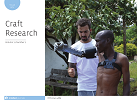-
oa Orientations on studying crafts in higher education
- Source: Craft Research, Volume 13, Issue Craft Sciences, Sep 2022, p. 411 - 432
-
- 31 Aug 2021
- 04 Apr 2022
- 01 Sep 2022
Abstract
Crafts in higher education (HE) are scattered and typically lack departments of their own, instead being integrated in art, design, technology, education or culture-oriented departments. The purpose of this research is to shed light on the orientations of crafts in HE programmes that have crafts as their foci. Based on document analysis of the curricula of one American and four European (Finland, Sweden, Estonia and United Kingdom) craft study programmes and fieldwork observations, the following five orientations were identified: educational crafts, traditional crafts, critical crafts, cultural heritage of crafts and design-based crafts. Both similarities and differences were found. The targets, prospective career paths and pedagogical methods of these study programmes were adapted to the broader targets of the various departments. Craft teaching followed the basic principles of studio pedagogy. The sought-after skill acquisition level varied from expressive purposes to ability to make quality products. There were also differences in whether a programme focused on a specific craft field or covered a broad spectrum. The requirements of academization were adapted in all study programmes. However, the role of writing differed from free and short reflective writing in the art department to a strict academic writing style in the education department. Professional goals varied from becoming a teacher or an artist to self-employment in a small-scale craft enterprise or achieving commercial success in industrial production. Concerns about losing craft traditions and dedication to maintaining them were shared across programmes. Despite being situated on the outskirts of academia, the status of crafts as an HE discipline adds value and visibility to the crafts and strengthens their identities.



